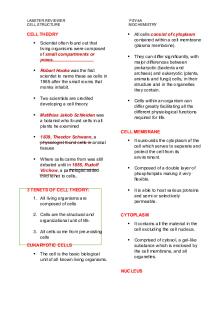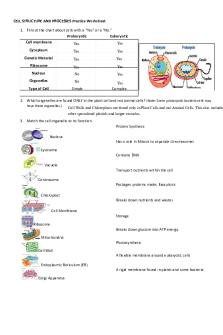Microbiology 2018-1-31 lecture 4 archaeal cell structure PDF

| Title | Microbiology 2018-1-31 lecture 4 archaeal cell structure |
|---|---|
| Author | Sarah Long |
| Course | Microbiology |
| Institution | Marist College |
| Pages | 6 |
| File Size | 151.6 KB |
| File Type | |
| Total Downloads | 71 |
| Total Views | 138 |
Summary
Professor Dragos's class...
Description
1
Microbiology 2018 February 5 LECTURE 4: Archaeal Cell Structure Archaea
Archaea and bacteria similar in terms of metabolic activity o Cell walls/membranes different from bacteria and eukaryotes Methanogenesis—ability to produce methane as a metabolic byproduct o Unique to Archaea
Size and shape
Cocci and rods are common cell shapes o Others include square, vibrio, etc. o No spirillum or spirochetes Sizes vary from 0.1 to >15 μ m
Archaeal cell envelope
Lack peptidoglycan: instead, some have pseudomurein o Cousin of peptidoglycan Some have S layers as part of cell wall instead of surrounding Some lack cell wall altogether Capsules and slime layers are rare Unique membrane lipids
Archaeal plasma membranes
Composed of unique lipids o Lipids have branched hydrocarbon tails o Ether linkages rather than ester linkages to glycerol Suggested that stronger ether link contributes to capability of Archaea to withstand harsh environments o Glycerol is mirror image from bacteria in terms of stereochemistry Some form monolayers
Archaeal cell walls
Most common cell wall is an S layer 6 basic types: o S layer, plasma membrane, cytoplasm o Protein sheath, S layer, plasma membrane, cytoplasm o Methanochondroitin, S layer, plasma membrane, cytoplasm o S layer, pseudomurein, plasma membrane, cytoplasm o Polysaccharides, plasma membrane, cytoplasm o Outerost membrane, intermembrane compartment, plasma membrane, cytoplasm
Archaeal cytoplasm
Nucleoid, not nucleus or nucleolus Inclusion bodies function in stockpiling nutrients Cytoskeletal proteins found in cytoplasm o FtsZ—forms central septum and allows cells to divide
Microbiology 2018 February 5 o MreB—coil shape in center of rod shapes that aids in cell division Nucleoid
Irregularly shaped region where single chromosome resides Not membrane bound Nucleoid proteins (NAPs) aid in supercoiling of DNA and allowing it to pack into cell
Archaeal external structures
Pili—assumed to function in attachment to tissues or other environmental surfaces Cannulae—hollow tube-like structures often found on thermophilic (heat-loving) Archaea o Believed to anchor cells to each other and function as means of communication Hami—look like pilli and radiate from outside of cell o Ends look like grappling hooks o Believed to function in attachment and biofilm formation
Differences of Archaeal flagella
Archaeal flagella are thinner, not hollow, and have multiple types of flagellin protein Hook made up of flagellin subunits Basal body exists
Archaeal DNA replication
Eukarya-like helicases and DNA polymerases o Helicase—breaks hydrogen bonds to “unzip” DNA during replication Bacteria-like circular chromosomes, plasmids, and bidirectional characteristics o Bidirectional—2 replication forks that occur in both directions
Archaeal transcription
TATA box—RNA polymerase recognizes TATA box to start transcription o Called a “pribnow” in bacteria Shorter consensus sequence Transcription occurs in cytoplasm in Archaea and bacteria and in nucleus in eukaryotes o Most things occur in cytoplasm due to lack of membrane-bound organelles
Archaeal translation
Bacteria have 70s ribosomes, Archaea have 80s ribosomes o Can undergo coupled transcription and translation Eukaryote-like elongation factors o Many RNA transcripts lack leader sequence st 21 and 22nd amino acids originally discovered in Archaea o Selenocysteine (Sec)—inserted in response to UGA codon in specific instances Present in some enzymes that protect against oxidative damage o Pyrrolysine (Pyl)—inserted in response to UAG codon in specific instances Only found in bacteria and Archaea Thought to play role in methanogenic ability
Protein secretion
2
Microbiology 2018 February 5
All domains can use Sec system o Archaea can use Sec and Tat systems Translocation system to move things from inside cell past plasma membrane Secretion means inside cell to outside cell completely Sec—unfolded proteins Tat—folded proteins Diseases mainly caused by secretion of toxins 1/3 of all proteins made within bacterial and Archaeal cells are secreted
Archaeal metabolism
3 pathways unique to Archaea o Embden-Meyerhof pathway—modified glycolytic pathway 1 glucose to 2 pyruvates o Entner-Doudoroff pathway—1 glucose to 2 pyruvates Lack pyruvate-dehydrogenase complex o Transition step to form acetyl-coA o Pyruvate oxidoreductase Some lack TCA cycle Use of Calvin cycle and alternative carbon fixation pathways
Thermostability
Many capable of withstanding high temperatures o Possibly due to stability of proteins Chaperones—partially refold denatured proteins Reverse DNA gyrase—induces positive supercoils in DNA o Tightens and prevents DNA from denaturing Topoisomerase—assists in unwinding of DNA Geogemma barossii (strain 121)—can replicate up to 121oC and replicate up to 130oC o Can survive sterilization in autoclave
Archaeal taxonomy
Two main phyla: Euryarchaeota, Crenarchaeota o Euryarchaeota Methanogens—derive energy from converting CO2 and other compounds to methane Largest group of Archaea Rods, cocci, curved rods, irregular Unusual metabolism Halobacteria—aerobic Require high salinity for growth o At least 1.5 M NaCl, optimum growth near 3-4 M NaCl Cubes, pyramids, rods, cocci Red to yellow pigments Thermoplasms—thermoacidophiles that lack cell walls Thermoplasma—59oC, 1-2 pH Picrophilus—47-65oC, 0 pH Extreme thermophiles—motile by multiple flagella
3
Microbiology 2018 February 5
4
88-100oC—hydrothermal vents, etc. Strictly anaerobic Sulfate-reducers—reduce sulfate to sulfide Irregular cocci cells Anaerobes Optimum 83oC o Crenarchaeota Sulfolobus—irregularly lobed, aerobic Thermoacidophiles—70-80oC pH of 2-3 ABC transporters—proteins embedded in plasma membrane that allow nutrients to make their way into the cell o Used for uptake of sugars into cell Membranes arranged in monolayers Thermoproteus—long, thin rods, anaerobic Thermoacidophiles o 75-100oC, pH of 3-4 Reductive TCA cycle—reverse of Krebs cycle o Carbon fixation pathway resulting in acetyl coA Membranes arranged in monolayers Lipotrachus flagella—three on one side Almost all Crenarchaeota are thermoacidophiles o Prefer high temperatures and low pH o
Archaeal cell surfaces
Euryarchaeota—if S layer is present, it is anchored to plasma membrane o 10-15 nm distance Crenarchaeota—S-layer distance is wider
Compare and contrast All Three Domains
Have a plasma membrane Have ribosomes DNA, at least one chromosome, some sort of genetic material Have a cytoplasm/cytoplasmic properties
Eukarya
Nucleus Organelles—mitochondria, ER, Golgi bodies, etc.
Archaea
Microbial nutrition
Pseudomurein Membrane lipids have ester linkages Stereochemistry of glycerol
Bacteria
Peptidoglycan Sporylation Hopanoids
Microbiology 2018 February 5
Nutrients used for variety of metabolic functions Passive diffusion—high to low concentration o H2O, O2, CO2 Facilitated diffusion—non-energy-dependent diffusion using transport proteins o Channels— o Carriers— o Smaller concentration gradient required o Larger molecules can be passed through membrane Sugars, amino acids, etc. o Solute binding causes conformational change o Solutes will move based on gradient Active transport—low concentration to high concentration o Energy-dependent (ATP) o Uses transport proteins o Primary active transport—uses ATP Molecule is not modified o Secondary active transport—use potential energy of ion gradients to transport substances Symport (coupled transport)—movement of two substances in the same direction Common for sodium, glucose Antiport—movement of two substances in opposite directions Common for sodium, calcium o Group translocation—low concentration to high concentration Energy dependent Glucose PEP Enzyme I HPr Enzyme IIA Enzyme IIB—phosphorylates glucose Enzyme IIC Chemically modifies molecules Phosphenolpyruvate-sugar phosphotransferase system (PTS)—phospho-relay system
Iron uptake
Required by microorganisms Difficult to take into cell and not always abundant in environment Siderophores—molecules that bind iron o Can be secreted from cell and taken back into cell through ABC transporter o Ferrichrome—fungal siderophore o Enterobactin—bacterial siderophore
Culture media
Solid or liquid medium used to grow, transport, and store microbes Must contain all the nutrients required by the organism for growth Examples: nutrient agar (solid), nutrient broth (liquid)
5
Microbiology 2018 February 5
6
Functional types of media
Supportive—supports many microorganisms o I.e. tryptic soy agar Enriched—good for fastidious microorganisms o Specific nutritional requirements o I.e. blood agar—often used for bacteria that grows in humans Selective
Differential media
Distinguishes microbes by their biological characteristics o I.e. blood agar—hemolytic vs nonhemolytic bacteria o I.e. MacConkey agar—lactose fermenters versus nonfermenters Different microbes appear different
Isolation of pure cultures
Colony—population of cells arising from a single cell Single colony moved to a separate vessel and grown on its own HAVE NOT COMPLETED CREATING A NEW COLONY UNTIL IT IS MOVED TO A FRESH VESSEL Methods of colony isolation: o Spread plate—small volume of diluted mixture spread evenly over surface with a sterile bent rod o Streak plate—streak mixed culture on plate Each cell can reproduce to form a separate colony Use a single colony to create a pure culture Split Petri dish into four quadrants, drag bacteria from first quadrant to second quadrant with sterile inoculation loop, repeat for rest of quadrants o Pour plate—mixture of cells and agar are poured into sterile culture dishes Sample is serially diluted Mixed with hot liquid agar and poured onto Petri dish...
Similar Free PDFs

Cell Structure SE 1
- 3 Pages

Labster 1 cell structure
- 10 Pages

Cell Structure (reviewer)
- 7 Pages

Structure of generalized cell
- 2 Pages

Cell Structure Worksheet
- 1 Pages

Cell Structure notes
- 13 Pages

Cell Structure Practice
- 3 Pages

CELL Structure OF Microorganisms
- 7 Pages

Prokaryotic Cell Structure
- 4 Pages

Cell Structure worksheet
- 3 Pages

1.b Cell Structure Worksheet
- 1 Pages

IB 1108 L10 Cell Structure
- 4 Pages

Cell Structure and Magnification PPQ
- 28 Pages
Popular Institutions
- Tinajero National High School - Annex
- Politeknik Caltex Riau
- Yokohama City University
- SGT University
- University of Al-Qadisiyah
- Divine Word College of Vigan
- Techniek College Rotterdam
- Universidade de Santiago
- Universiti Teknologi MARA Cawangan Johor Kampus Pasir Gudang
- Poltekkes Kemenkes Yogyakarta
- Baguio City National High School
- Colegio san marcos
- preparatoria uno
- Centro de Bachillerato Tecnológico Industrial y de Servicios No. 107
- Dalian Maritime University
- Quang Trung Secondary School
- Colegio Tecnológico en Informática
- Corporación Regional de Educación Superior
- Grupo CEDVA
- Dar Al Uloom University
- Centro de Estudios Preuniversitarios de la Universidad Nacional de Ingeniería
- 上智大学
- Aakash International School, Nuna Majara
- San Felipe Neri Catholic School
- Kang Chiao International School - New Taipei City
- Misamis Occidental National High School
- Institución Educativa Escuela Normal Juan Ladrilleros
- Kolehiyo ng Pantukan
- Batanes State College
- Instituto Continental
- Sekolah Menengah Kejuruan Kesehatan Kaltara (Tarakan)
- Colegio de La Inmaculada Concepcion - Cebu


